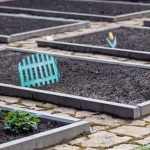Terraced vegetable gardens offer a unique and practical solution to maximizing space while cultivating a thriving garden. The use of raised, flat platforms on sloped land allows for efficient use of space and improved drainage. From planning and construction to cultivation and harvesting, terraced vegetable gardens present an opportunity for both beginners and experienced gardeners to grow a wide variety of crops in a visually striking manner.
One of the main benefits of terraced vegetable gardens is their ability to create level planting areas on uneven terrain, making it possible to grow vegetables in areas that would otherwise be unsuitable for gardening. This method also helps prevent soil erosion by slowing down the flow of water and giving it time to soak into the ground.
Additionally, terraces provide better access for tending plants and harvesting crops, making them an attractive option for home gardeners looking to make the most of limited space.
In this comprehensive guide, we will explore everything you need to know about creating and maintaining your own terraced vegetable garden. We will discuss planning considerations, construction methods, vegetable selection, maintenance tips, and even provide inspiration from successful terraced gardeners. Whether you’re looking to transform a hilly backyard or simply intrigued by the concept of terraced gardening, this article will equip you with the knowledge and inspiration needed to embrace the beauty and productivity of terraced vegetable gardens.
Planning Your Terraced Vegetable Garden
When planning a terraced vegetable garden, there are several key considerations to keep in mind in order to ensure its success. The first step is to choose the right location for your terraced garden. Look for a spot that receives plenty of sunlight and has good drainage to promote healthy plant growth. Additionally, consider the accessibility of the site and how easy it will be to tend to your garden once it’s built.
Design considerations for a terraced garden are also important. Think about the layout of your garden and how you want to arrange the terraces. Consider incorporating steps or pathways between each level for easy access. You’ll also need to think about the materials needed for building the terraces, such as wood, stone, or concrete blocks. Each material has its own advantages and drawbacks, so it’s important to choose what’s best for your specific needs.
When building terraces for your vegetable garden, it’s essential to follow a step-by-step guide on constructing them properly. Additionally, ensuring stability and durability of the terraces is crucial in preventing erosion and maintaining the overall integrity of your garden. Consider incorporating irrigation and drainage systems into the design of your terraces to ensure proper water distribution and prevent waterlogging.
By carefully planning your terraced vegetable garden, you can create a beautiful and productive space that will provide you with an abundant harvest throughout the growing season. With thoughtful consideration given to location, design, materials, construction techniques, and irrigation systems, you can set yourself up for success when embarking on this rewarding gardening adventure.
Building Terraces for Your Vegetable Garden
Step-by-Step Guide on Constructing the Terraces
Building terraces for your vegetable garden can be a rewarding and relatively simple process with the right tools and materials. Start by marking out the area where you want to create your terraces, ensuring that they are oriented in a way that maximizes sunlight exposure for your plants. Once marked, it’s time to start creating the physical structure of the terraces.
Begin by building retaining walls or using other methods to secure the soil in place as you build up each terrace. This may involve using bricks, stones, or timber to create sturdy barriers that prevent erosion and slippage of the soil.
Next, fill in each terrace with soil, making sure to pack it down firmly to provide a stable foundation for planting. Consider incorporating organic matter such as compost or manure into the soil to improve its fertility and drainage capabilities. Finally, create pathways or access points between each terrace so you can easily move around and tend to your crops.
Tips for Ensuring Stability and Durability of the Terraces
One of the most important considerations when building terraces for your vegetable garden is ensuring their stability and long-term durability. To achieve this, it’s essential to use high-quality materials and construction techniques that can withstand the weight of soil, water, and plant roots. Additionally, proper drainage is crucial for preventing water from accumulating behind or within the terraced layers, which could lead to instability or erosion.
Another tip for maintaining stability is to consider investing in geotextiles or erosion control fabrics that can help reinforce the soil within each terrace while allowing water to drain freely. Regular maintenance tasks such as inspecting retaining walls for signs of wear or damage can help prevent structural issues before they become serious problems.
Incorporating Irrigation and Drainage Systems
Lastly, consider incorporating irrigation and drainage systems into your terraced vegetable garden design to ensure optimal growing conditions for your crops. Depending on the size of your garden and its specific layout, you may choose to install drip irrigation lines along each terrace or implement a system of swales and drains that help direct excess water away from your plants.
Additionally, strategically placing rain barrels at higher levels of your garden can allow gravity to assist in watering lower sections through a series of interconnected hoses or pipes. By customizing an irrigation system that suits your particular needs and environmental factors such as rainfall patterns and sun exposure, you can help promote healthy plant growth while conserving water resources at the same time.
Selecting the Right Vegetables for Your Terraced Garden
Terraced vegetable gardens offer a unique way to grow a variety of crops in limited space while also preventing soil erosion. When selecting the right vegetables for your terraced garden, it’s important to consider the specific growing conditions and challenges that come with this type of setup.
Here are some considerations to keep in mind when choosing the best vegetables for your terraced garden:
1. Root Vegetables: Root vegetables such as carrots, radishes, and potatoes are well-suited for terraced gardens because they require less vertical growing space. They can be planted in the lower terraces where there is more soil depth, allowing them to develop healthy and hearty roots.
2. Compact or Dwarf Varieties: Opt for compact or dwarf varieties of plants such as tomatoes, peppers, and eggplants. These smaller plants take up less space but can still produce a generous yield, making them ideal for terraced gardens with limited area.
3. Leafy Greens: Vegetables like lettuce, spinach, and kale are excellent choices for terraced gardens due to their shallow root systems. They can thrive in the smaller pockets of soil found on each level of the terraces, ensuring that you make the most out of your vertical growing space.
When planting your terraced vegetable garden, it’s important to consider how different plants will interact with one another in terms of their height and growth habits. By carefully choosing a combination of vegetables that complement each other’s needs and thrive in this unique environment, you can maximize productivity and enjoy a bountiful harvest from your terraced vegetable garden.
Maintaining and Caring for Your Terraced Vegetable Garden
Once your terraced vegetable garden is established, it’s important to maintain and care for it properly to ensure a bountiful harvest. Here are some tips and techniques for keeping your terraced garden healthy and productive:
1. Watering: Proper watering is essential for the success of your terraced vegetable garden. Depending on the location and climate, you may need to water the plants more frequently, especially during the hot summer months. Consider incorporating a drip irrigation system or soaker hoses into your terraces to ensure that each level receives adequate moisture.
2. Fertilizing: As the plants grow and produce vegetables, they will deplete the nutrients in the soil. Regularly fertilize your terraced garden with organic or synthetic fertilizers to provide essential nutrients for healthy growth and high yields.
3. Pest and Disease Control: Keep an eye out for common pests and diseases that can affect vegetable gardens, such as aphids, caterpillars, and fungal infections. Implement integrated pest management techniques, such as using natural predators or organic sprays, to control pests while minimizing harm to beneficial insects.
4. Seasonal Maintenance: Throughout the growing season, there will be various maintenance tasks to attend to in your terraced vegetable garden. These may include pruning plants, removing weeds, and providing additional support for heavy fruiting crops like tomatoes or cucumbers.
By following these maintenance guidelines, you can ensure that your terraced vegetable garden remains healthy, vibrant, and productive throughout the growing season.
Remember that caring for a terraced vegetable garden requires dedication and attention but will ultimately reward you with an abundant supply of fresh produce right at your doorstep.
Harvesting and Enjoying the Fruits of Your Labor
After all the hard work of planning, building, and maintaining your terraced vegetable gardens, it’s finally time to reap the rewards. Harvesting your fresh produce is not only satisfying, but it also allows you to enjoy the fruits of your labor in a delicious and rewarding way. Here are some tips for maximizing the yield from your terraced garden.
Firstly, it’s important to keep a close eye on your vegetables and harvest them at the peak of ripeness. This ensures that you get the best flavor and nutritional value from your produce. Be sure to check your garden regularly and harvest as soon as your vegetables are ready. Some vegetables, such as zucchini and cucumbers, can grow very quickly so it’s important to keep an eye on them.
Once you have harvested your bountiful supply of fresh vegetables from your terraced garden, it’s time to put them to good use. There are endless possibilities for incorporating your homegrown produce into creative recipes and cooking ideas.
Whether you’re making a fresh summer salad with crisp lettuce and juicy tomatoes or whipping up a batch of homemade salsa with your ripe peppers and onions, there’s nothing quite like enjoying the taste of food that you’ve grown yourself.
| Terraced Vegetable Garden Tip | Details |
|---|---|
| Maximizing Yield | Regular harvesting at peak ripeness. |
| Creative Recipes | Incorporate homegrown produce into various recipes. |
Success Stories and Inspirational Examples of Terraced Vegetable Gardens
Real-Life Examples of Successful Terraced Vegetable Gardens
One inspiring success story of a terraced vegetable garden comes from a family in the hilly region of Tuscany, Italy. Faced with limited flat land for gardening, they decided to create a series of terraces on the sloping landscape behind their home.
Today, their terraced garden is not only a beautiful sight to behold, but it also provides an abundant harvest of tomatoes, zucchinis, and herbs. The family has found that the terraces help to maximize space and capture water, making it a sustainable and productive way to grow vegetables.
Another remarkable example of a successful terraced vegetable garden can be found in the mountains of Nepal. Due to the steep terrain in this area, farmers traditionally struggled to cultivate crops. However, with the introduction of terraced vegetable gardens, many have been able to increase their food production significantly. These terraces have not only improved the livelihoods of these farming communities but have also helped prevent soil erosion and promote biodiversity in the region.
Testimonials From Gardeners Who Have Found Success With Terraced Gardens
“I never imagined that I could grow such a variety of vegetables in my backyard until I built my own terraced garden. The different levels allow me to plant crops that have different sunlight and drainage needs, resulting in healthier plants and higher yields,” shared Susan R. a dedicated gardener from California.
“After struggling with poor soil conditions and limited space for so long, venturing into terraced gardening was truly life-changing for me. Not only am I able to grow more food than ever before; my terraced garden has become a peaceful sanctuary where I can reconnect with nature,” expressed John D. an enthusiastic gardener from New Zealand.
Inspirational Photos and Stories to Motivate and Inspire Readers
Seeing is believing. Browse through these stunning photos showcasing gorgeous terraced vegetable gardens around the world. From vibrant arrays of colorful bell peppers growing on every level to cascading rows of leafy greens flourishing on steep hillsides, these images are sure to ignite your passion for creating your own thriving terraced garden.
Furthermore, read heartwarming accounts of individuals who transformed challenging landscapes into flourishing havens through the art of terrace gardening. There’s no shortage of inspiration when it comes to embracing the beauty and productivity of terraced vegetable gardens.
Conclusion
In conclusion, terraced vegetable gardens offer a beautiful and productive way to grow your own food while maximizing space and creating an aesthetically pleasing outdoor environment. From their numerous benefits for soil retention and water conservation to the opportunity to grow a diverse range of vegetables, terraced gardens are a fantastic option for many gardeners. By embracing terraced vegetable gardening, individuals can enjoy the satisfaction of growing their own fresh produce while also creating an inviting outdoor space.
As you consider starting your own terraced vegetable garden, it’s important to remember the key planning and maintenance considerations outlined in this article. Choosing the right location, understanding the materials needed for building terraces, selecting appropriate vegetables, and implementing proper maintenance techniques are all essential components of successful terraced gardening. With careful planning and ongoing care, you can create a thriving terraced garden that provides bountiful harvests throughout the growing season.
Whether you are new to gardening or have years of experience, embracing the beauty and productivity of terraced vegetable gardens can be a rewarding endeavor. With opportunities to connect with nature, nurture healthy plants, and enjoy homegrown produce, there’s much to gain from incorporating terraced gardening into your outdoor space.
And as you embark on this journey, be sure to seek inspiration from success stories and examples of others who have found joy and abundance in their own terraced gardens. Happy gardening.
Frequently Asked Questions
How Do You Make a Terraced Vegetable Garden?
Making a terraced vegetable garden involves creating multiple levels of flat areas on a slope, using retaining walls or other structures to prevent soil erosion. This allows for better water retention and easier maintenance.
What Are the Disadvantages of a Terrace Garden?
One disadvantage of a terrace garden is the potential for structural failure if not built properly, leading to soil erosion and damage to plants. Additionally, terrace gardens may require more initial setup and investment.
What Is the Most Efficient Vegetable Garden Layout?
The most efficient vegetable garden layout depends on factors such as the available space, climate, and types of vegetables being grown. However, raised beds with wide paths in between can minimize water wastage and make it easier to maintain the garden.

If you’re looking to get into vegetable gardening, or are just looking for some tips on how to make your current garden better, then you’ve come to the right place! My name is Ethel and I have been gardening for years. In this blog, I’m going to share with you some of my best tips on how to create a successful vegetable garden.





